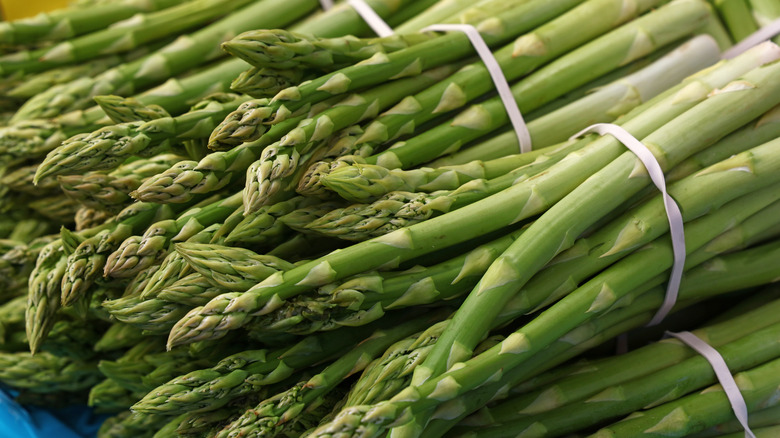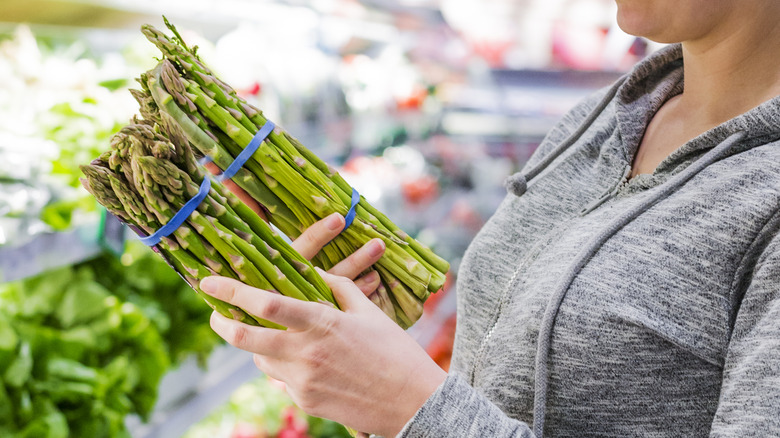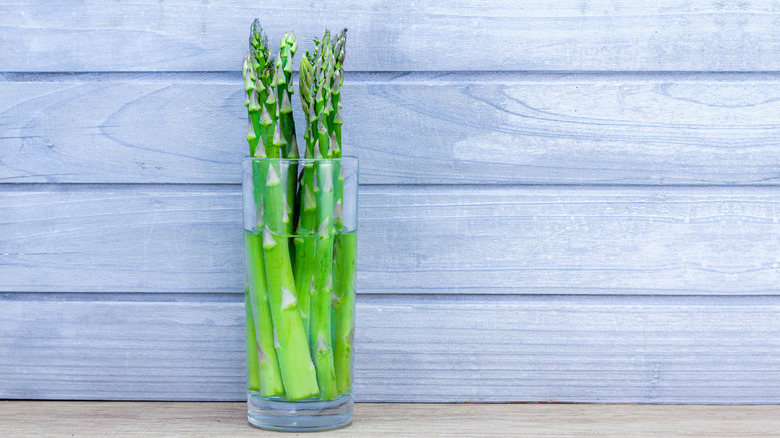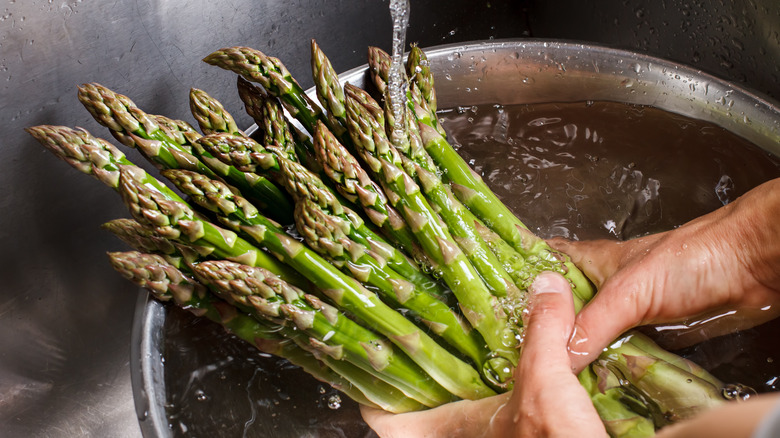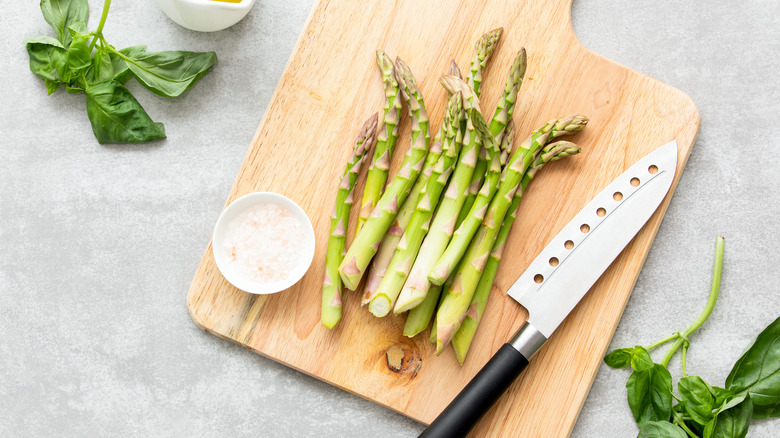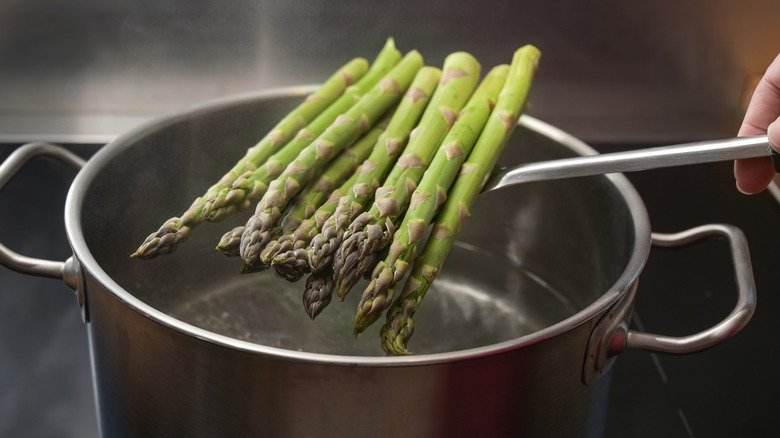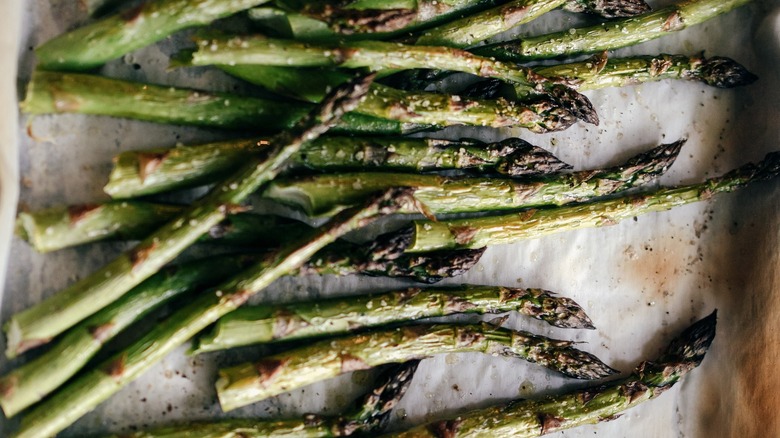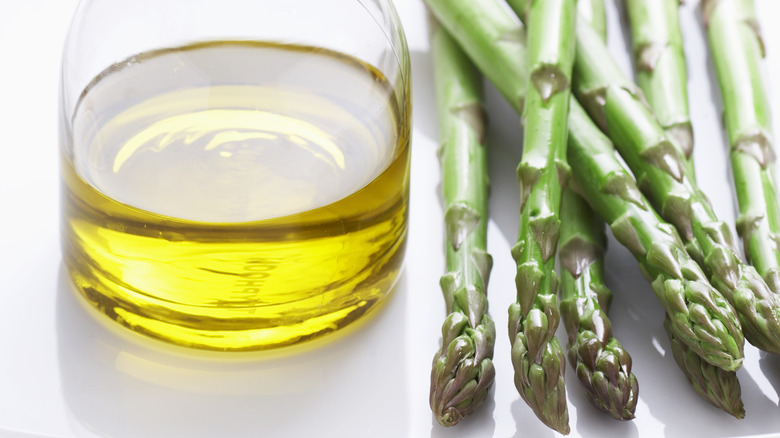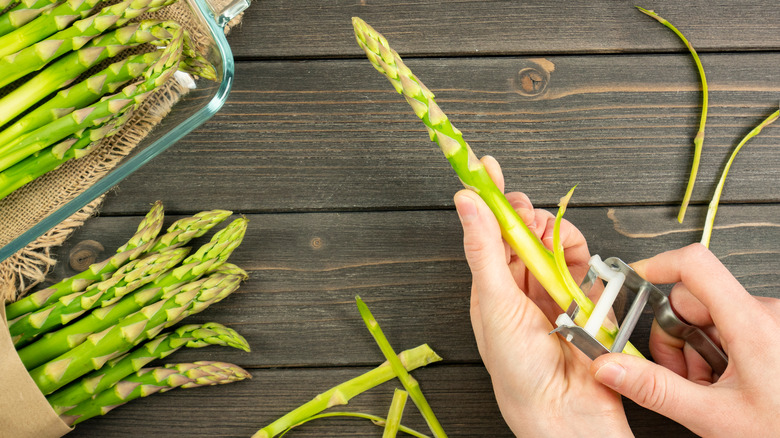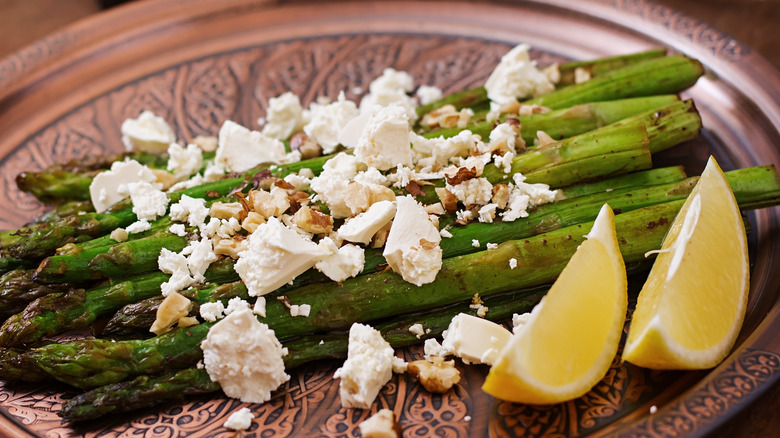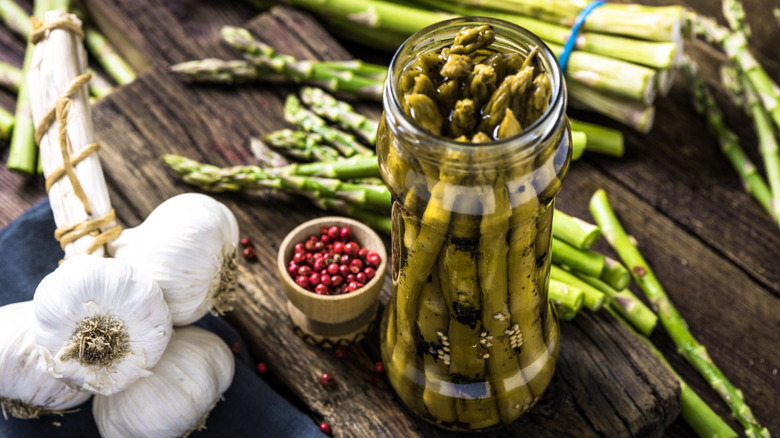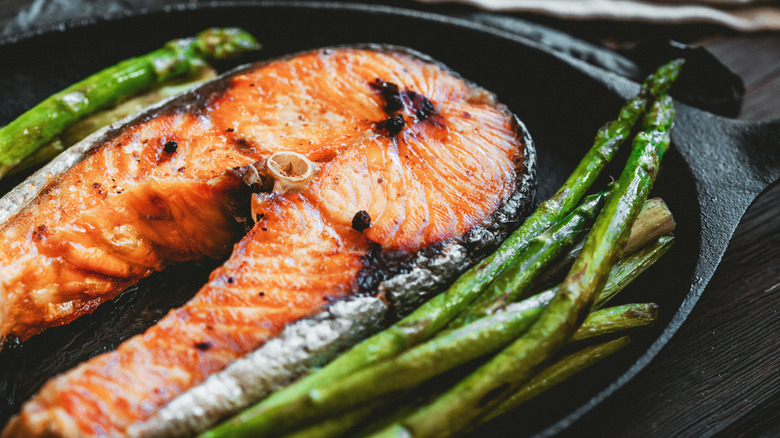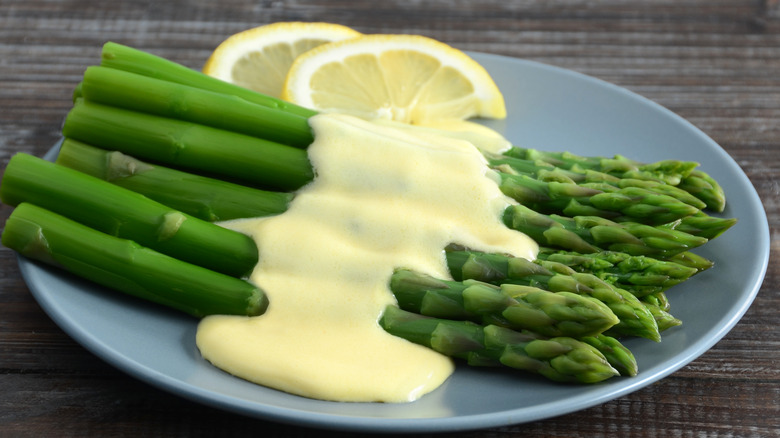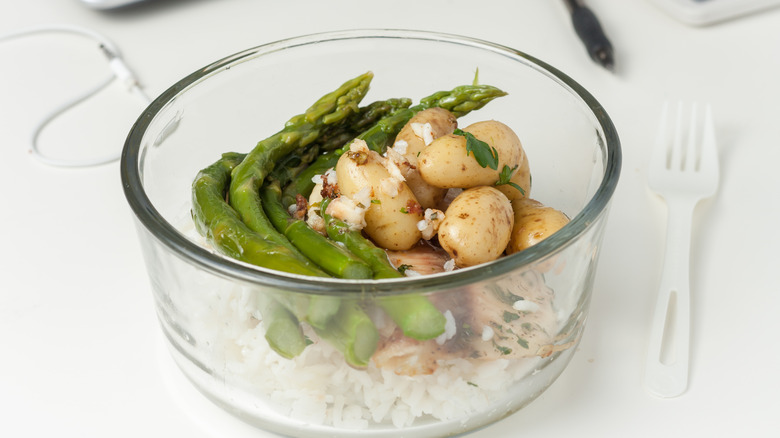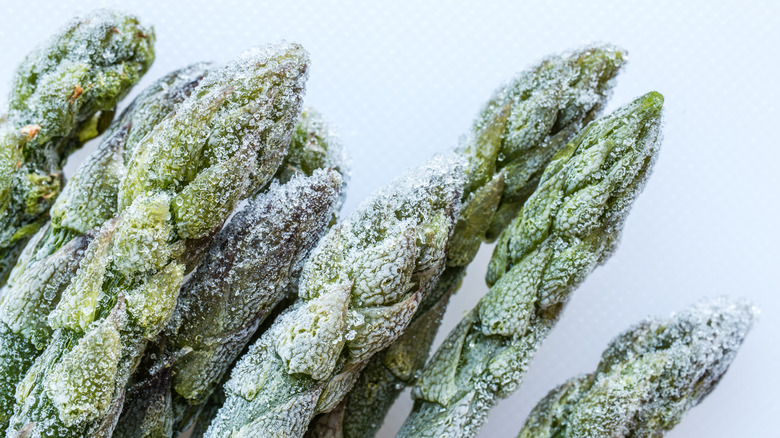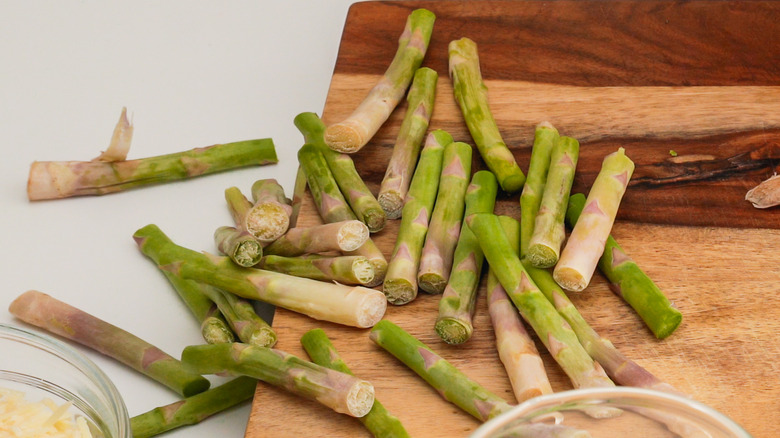15 Asparagus Mistakes You Need To Stop Making
Asparagus is one of those incredible foods that truly has no counterpart. From its earthy, slightly bitter, subtly sweet flavor to a crisp, tender consistency and a unique look and shape, there's nothing else quite like it.
Some might say it tastes a bit like Brussels sprouts or cabbage, and the way it grows in wooded areas is a little like a mushroom. These green beauties are actually a relative of onions, garlic, and leeks — but none of those foods give you the rich, nutty, almost grass-like taste you get from fresh, in-season asparagus. It truly is a special vegetable.
You wouldn't know that, however, by the way some people treat these jade stalks of goodness. From storing in thick plastic bags where they can't properly breathe to boiling them until they become a limp, flavorless noodle, asparagus is one of those foods that need to be handled with care. Avoid such blunders, common with even the most well-intentioned of foodies and home chefs, with tips below on the most common mistakes made. Are you one of the masses abusing what could potentially be a beloved part of your mealtime routine? Read on, and find out.
Stop buying the wrong stalks
Freshness is crucial when it comes to buying asparagus. Whether you're shopping at a farmer's market or your local grocery store, make sure you purchase stalks that are crisp, firm, and vibrant in color.
You should always avoid asparagus with wilted or mushy spears, or tips beginning to turn yellow. If the tips of the spears are tightly closed, that means the asparagus is fresher, and was more recently harvested. Open or feathery tips, on the other hand, belie older or more mature asparagus, which may have a tougher texture.
Don't allow yourself to be swayed by the size of the spears. Although some people swear by fatter stalks, most chefs agree that thinner spears tend to be more tender and flavorful — and they also cook more quickly. Finally, before you add that selection of asparagus to your cart, take a good sniff. Fresh asparagus should have a mild, earthy aroma. If you detect any strange or slightly fermented odors, grab a different bundle.
Make sure you store your asparagus correctly
One of the most challenging aspects of preparing fresh asparagus is in storing it before cooking. It simply isn't one of those veggies you can keep in the bag or toss into the fridge until needed. But, show your asparagus a little love and it will keep for days.
To start, make sure you trim about half an inch from the bottom of the asparagus spears. You can cut your whole bundle of asparagus at once with a knife — no need to break them free just yet. Then fill a glass or jar with an inch or two of water, and stand your asparagus up inside it — like flowers in a vase — with the cut ends submerged. Alternately, if you don't have glass space, you can wrap the trimmed ends in a damp paper towel before refrigerating. Stored this way in a cold fridge, most asparagus will keep for 3 to 5 days — plenty of time to put those bitter, nutty spears of deliciousness to use in any favorite recipe.
Avoid these common asparagus washing blunders
One of the most common mistakes you can make when cleaning asparagus is not rinsing the spears thoroughly enough. Asparagus can accumulate a great deal of dirt, sand, or other debris as it grows. If you don't rinse it well, it can end up tasting gritty. To avoid this, hold the asparagus under cool running water and gently rub the stalks to remove any dirt they might be hiding. But do it quickly. You don't want to over-soak those spears. If you do, the asparagus can become soggy and may end up losing much of its natural flavor.
Another essential rule? Always use cold water when washing asparagus. Hot water can cause the spears to become limp and lose their natural crispness. After washing, take a minute to properly dry the spears. Gently pat them with a clean kitchen towel or paper towels. And finally, don't wash your asparagus spears in advance or they can also lose their crunch. For the best tasting asparagus, save the cleaning until right before you plan on cooking the vegetable.
Snap — don't cut — the stems
Do you want to look like a professional chef when preparing your asparagus? Then ditch the knife and cutting board. Snapping asparagus spears instead of cutting them is the way to go.
Here's how it works: Asparagus spears have a natural breaking or snapping point, typically located towards the bottom end of the stalk. When you bend the spear gently from its base, it will naturally break where the woody, tough part of the spear meets that tender, more edible section of the plant. The beauty of this technique is that it's quick — you can just snap and go. Also, you don't have to guess where the tender part of the spear starts or stops, just let that natural breaking point decide for you.
Snapping asparagus spears instead of cutting them generally leads to less waste — the spear generally breaks lower than where you might have been drawn to cut. This means you also get more asparagus to eat, when all is said and done. Finally, when you snap instead of cutting, all the asparagus in your dish is more likely to have the same tenderness and texture, so you also get a more consistent dish overall.
Stop overcooking it
Everyone knows what they want a perfectly cooked spear of asparagus to look like: Vibrant green, tender yet firm, crisp with just the slightest snap when biting into a spear. But instead, many end up with dull, faded spears that are limp or mushy and completely devoid of crispness. The problem, almost always, is overcooking.
While boiling and steaming tends to be the go-to methods for cooking asparagus, care still needs to be taken to ensure that asparagus comes out looking and tasting as intended. Rule one: Don't leave asparagus cooking unattended. Let it steam or boil for about 3 to 5 minutes max, then test for doneness. Pierce the thickest part of the spear with a fork or the tip of a knife. It should offer slight resistance, but still be tender.
Rule two: When your asparagus is done, don't just turn off the heat and let it sit in the hot water. If you plan on serving your asparagus cold (such as in a salad), immediately transfer it to an ice bath or run it under cold water to halt the cooking process. If you plan on eating it warm, remove it from the hot water and let it sit on a paper towel-coated tray, or immediately plate it and serve.
Experiment with alternate ways to cook it
As great as boiled and steamed asparagus can be, don't limit yourself to only cooking with the methods described above. There are dozens of different ways you can prepare and serve asparagus. Grilled asparagus is one great option, because it gives the asparagus a unique, smokey char. You can grill spears directly over open flames for around 8 to 10 minutes, turning occasionally. Roasted asparagus is another great option. Just heat the oven to 425 degrees Fahrenheit and cook for 12 to 15 minutes, or until the spears are lightly golden.
Alternatively, asparagus can be baked or grilled in an aluminum foil pouch. Just lay some spears on a piece of foil, add a bit of olive oil and salt, and then fold all the ends of the foil together, locking the spears inside. Cook on the grill, or in the oven, for 20 to 30 minutes or until the spears are soft.
If cooking on the stove top, try stir-frying the spears until crisp and tender, or sautéing over medium high eat. Each technique needs just a dab of oil and takes around 5 to 7 minutes.
Finally, don't underestimate the incredible taste of homemade pickled asparagus, asparagus soup, or an amazing appetizer like asparagus that has been wrapped in prosciutto and then baked until crispy. It's easy, and delicious.
Avoid using too much oil
It's easy to accidentally drown asparagus. Using too much oil when cooking can overpower the natural taste of the asparagus, overwhelming its unique nutty, crispy bite. This overdose of oil is especially common when grilling or broiling asparagus, or pan-frying or sautéing the vegetable. Luckily, this is one problem that's easy to avoid: Simply use less oil.
Sautéing and stir-frying tend to be two cooking techniques that require the least oil. When cooking asparagus via these methods, use just enough oil to coat the surface of the pan; the asparagus should not be submerged. Start with a teaspoon of oil, then gradually add more as needed until the pan's surface is just coated. If grilling or broiling, toss the asparagus with just enough oil to leave them lightly coated. They should not be sitting in oil. If there is excess, blot it off with a paper towel before putting them on to cook.
Always peel the thicker spears
Peeling asparagus isn't always necessary, especially if you have young, thin spears. However, if you get an unusually thick or chunky batch of asparagus, or the spears appear to be somewhat tough, peeling could be a good idea. It allows for more consistent cooking (since all the peeled asparagus will be about the same thickness) and can even fancies-up the look of the asparagus, giving it a smoother, more polished appearance — important if preparing a meal and eager to impress.
To peel asparagus, grab any sharp vegetable peeler. Hold the asparagus spear firmly at the base with one hand and the peeler with the other. Then, begin peeling from about an inch or two below the top tip of the asparagus, moving down towards the base. Apply gentle pressure and run the peeler down the length of the spear. Peel off only the outer layer — be careful not to nick or remove any edible flesh. Continue peeling until you reach just above the woody end. Then rotate and repeat until all the way around each spear. Voila — they are now ready to cook.
Don't add acid too early
No matter how you're preparing the asparagus, acidic ingredients like lemon juice or vinegar can be a great compliment. They provide what chefs call "brightness" to the dish, enhancing the flavor of the vegetable and helping to make it tangier and more refreshing while also highlighting its natural earthiness. However, a word of warning: if wanting to use either ingredient with asparagus, be careful of the amount.
Too much of either lemon juice or vinegar could potentially overpower the delicate flavor of the those spears. Start with a small amount, a squeeze of lemon juice or a tablespoon of vinegar, and then add more as needed.
Even more importantly, don't add that acid too soon. Use lemon juice or vinegar towards the end of the cooking process, just before the asparagus is done and ready to serve. If acid is added to asparagus too early, it can wreak all sorts of havoc. It may wash the color out of the spears, making them appear faded. It could also potentially start to break down the structure of the asparagus, making it limp or mushy.
Pickling is an option
Speaking of acid and asparagus, don't forget just how great — and easy — pickling those emerald spears can be. Cucumbers, cabbage, and green beans aren't the only veggies that make great pickles. Fresh asparagus can also quickly be pickled to create tangy, potent spears that can be used in countless ways.
To make DIY pickled asparagus, just prepare a basic pickling brine — for example, 1 cup white vinegar, 1 cup water, 2 tbsp sugar, 1 tbsp salt plus a choice of garlic, black pepper, mustard, red pepper flakes, or other spices. Heat the mixture until boiling, then let cool to room temperature. While the brine heats, pack fresh asparagus spears into a large clean jar. Pour the cooled brine over the asparagus, making sure the spears are fully submerged. Put a lid on the jar and everything into the fridge for at least 24 hours to chill and marinate. The longer the asparagus pickles, the more flavorful the spears will become.
Stop pairing asparagus with the wrong foods
When finalizing plans on how you want to cook and serve asparagus, the next thing to decide is what types of foods it will be complimenting. In general, the rule here is to look for flavors that help it shine — other umami-forward, earthy and nutty dishes that will help the natural, slightly bitter taste of the asparagus soar.
It's also important to strive for a balance of flavors and textures, and avoid pairing with other strong, overpowering flavors. Asparagus typically doesn't go well with very sweet foods like watermelon, overly ripe bananas, or sweet sauces. This is also true of extremely spicy dishes which may overpower its delicate flavor, strong cheeses, or veggies with a similar flavor profile, such as cabbage or Brussels sprouts. Instead, focus on the many foods that are ideal as an accompaniment for asparagus, including mild to rich meats like salmon and prosciutto or a rich steak, eggs, mushrooms, pasta, and other dishes with lemon, garlic, olive oil, or balsamic vinegar-forward flavor profiles.
Don't use too much sauce
While putting a very sweet sauce on asparagus is almost always a no-no, asparagus otherwise loves to be sauced. Its bitter, buttery, vegetal flavor simply shines — and becomes even more rich and robust — with a sauce that perfectly complements its taste and texture.
A beautiful lemon butter sauce can help bring out its deep earthy goodness. Or perhaps a rich, creamy Hollandaise made with egg yolks, butter, and lemon juice that adds a velvety, luxurious touch to those emerald green spears. A tangy balsamic glaze can bring a hint of caramelization to asparagus, enhancing its natural sweetness, while a mustard vinaigrette might help to give it a zesty kick.
The one thing all of these sauces have in common, however, is they should be used sparingly. Asparagus has a delicate flavor, and overwhelming it with excessive sauce can mask its exquisite taste and texture. So, start with a small amount of sauce and gradually add more as desired, making sure that your asparagus remains the focal point of the dish.
Never reheat asparagus in the microwave
Asparagus is one of those veggies that can taste just as good as leftovers the next day as when you originally made it — unlike leafy greens, cucumbers or fresh tomatoes that don't hold up as well to storing and reheating. The trick, however, is to make sure that if you're going to reheat your asparagus, you do it in proper right way.
This means using a stovetop or oven, never the microwave. While it is a bit faster, nuking leftover asparagus essentially steams it again, generally turning it into a pile of mush. The better way to go, whether you're adding that leftover asparagus to a pasta dish, a stir-fry, or even a quiche or frittata, is to reheat it with dry heat. That means including it as part of something you fry or bake in the oven — or, if you are eating it on its own, roasting it in an uncovered baking dish until warm or sautéing it on the stove with a small amount of oil or butter. The less liquid or steam it encounters, the firmer those delicious spears will stay.
Don't let excess asparagus spoil — freeze it
Maybe the grocery store was having a two-for-one special on fresh asparagus. Or maybe the dinner plans kept changing. Whatever the case, you now find yourself with a bunch of asparagus on the verge of spoiling if it isn't used soon. Sound familiar? Well, instead of just calling that produce a loss and tossing it in the trash, freeze those extra spears. Asparagus is among a number of veggies that keep wonderfully on ice.
To freeze asparagus for later use, first wash it and snap the tough ends off the spears. Next, blanch it, submerging the spears in boiling water for two to three minutes. The blanching process helps keep the flavor of the asparagus from changing once frozen. After blanching, drain and dry the asparagus. Let the spears cool, put them into a large freezer bag, and store. When frozen, asparagus will keep on ice for up to half a year.
Use asparagus ends to make stock
All those leftover woody asparagus ends everyone throws away could actually be put to good use. Instead of tossing in the trash, use them to make asparagus stock.
The process is super easy. Simply wash the ends to remove any potential debris, then chop them into one-inch chunks and add to a large pot with around 4 cups of water. Toss in some added aromatics, such as onion, garlic, celery, carrots — or herbs, like thyme or parsley. Bring the mixture to a boil and let it simmer for about 30 to 45 minutes; when the stock is done, let cool and then strain through a fine-mesh sieve.
Asparagus stock can be employed as a base for any number of dishes including soups, risottos, sauces, and stews. It can also serve as the backbone for any recipe that calls for chicken or vegetable stock. This unique substitution will add the distinct flavor of asparagus to any recipe, and if you make extra, just freeze it for later.

